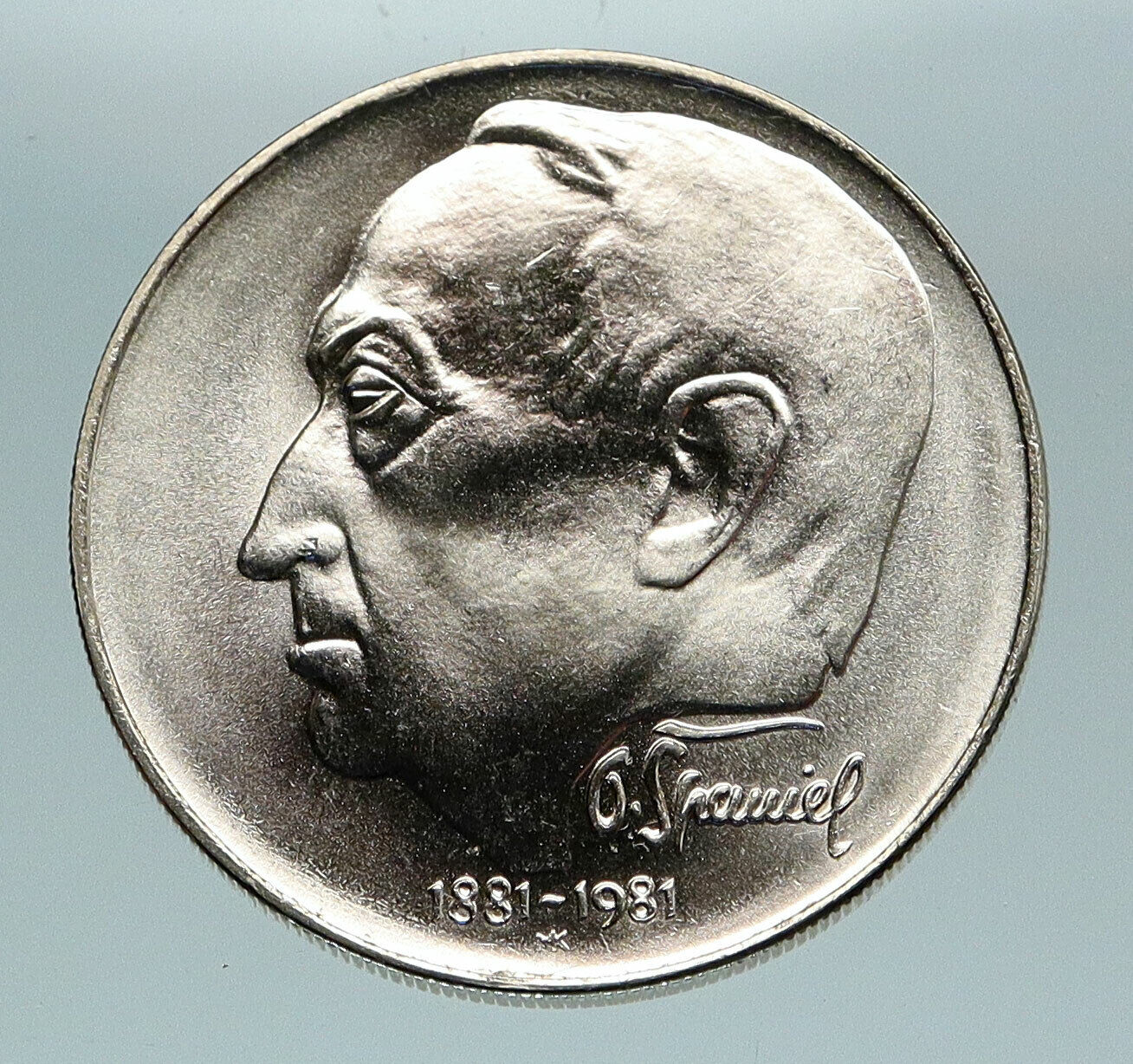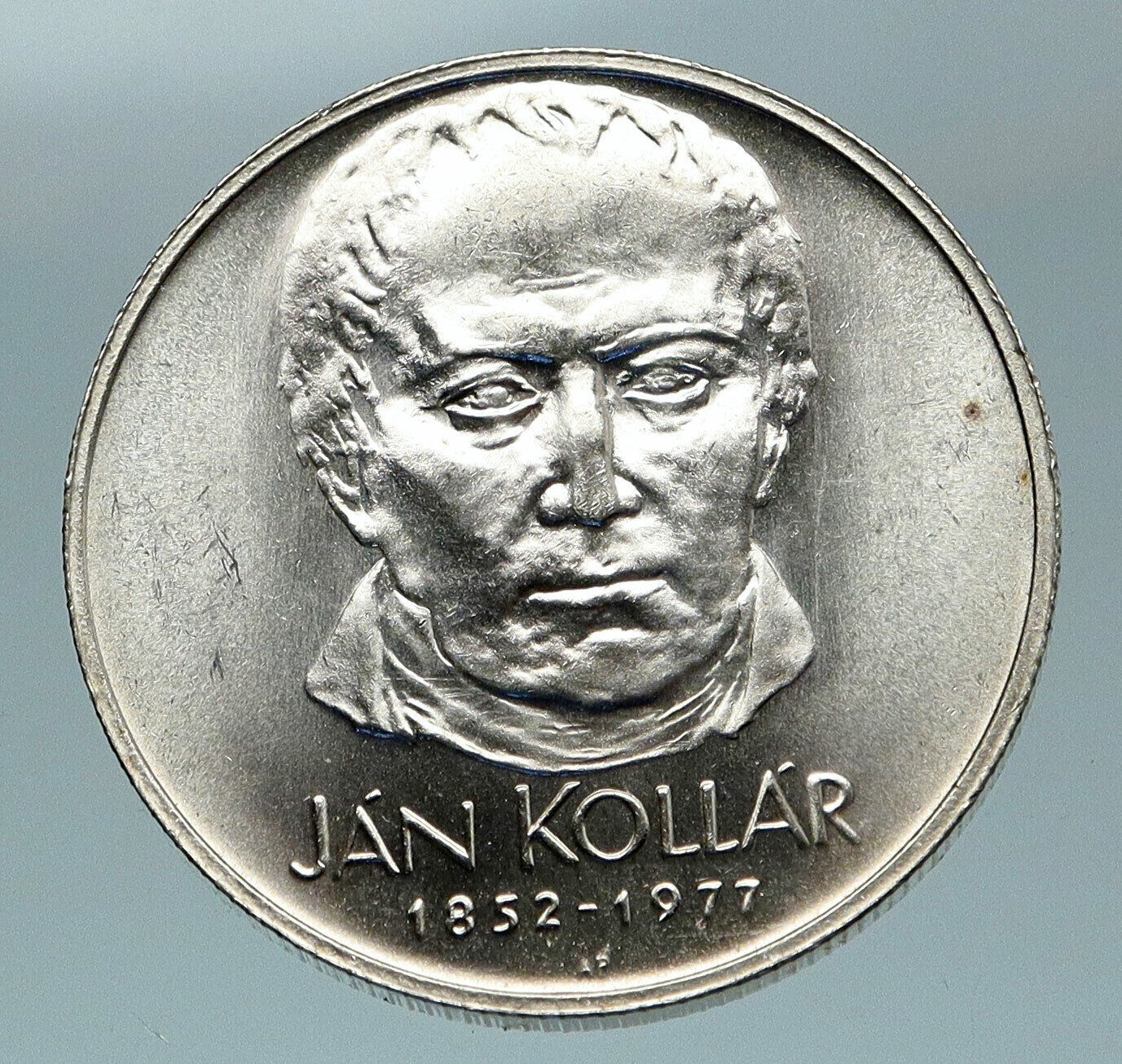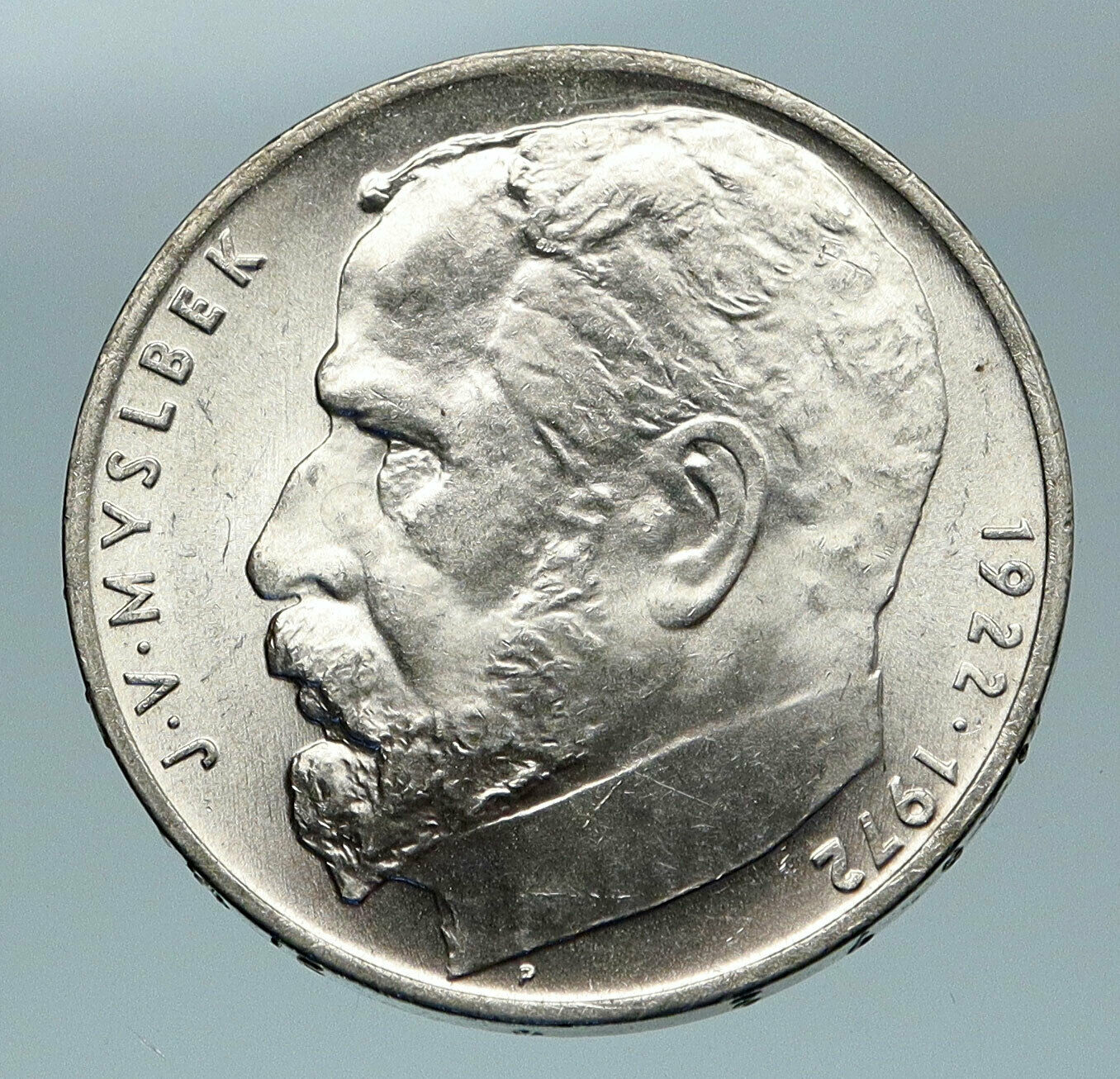|
Slovakia – St. Cyril and St. Methodius
1941 Silver 20 Korun 31mm (14.97 grams) 0.500 Silver (0.2411 oz. ASW)
Reference: KM# 7.1
SLOVENSKÁ REPUBLIKA F Š Slovak shield with linden spring below; year.
20 Ks, St. Kyrill and St. Methodius; Cross on church at lower right.
You are bidding on the exact item pictured, provided with a Certificate of Authenticity and Lifetime Guarantee of Authenticity.
Saints Cyril and Methodius (826-869, 815-885; Greek: Κύριλλος καὶ Μεθόδιος (Kýrillos kaí Methódios), Old Church Slavonic: Кѷриллъ и Меѳодїи[more])  were two brothers who were Byzantine Christian theologians and Christian missionaries. Through their work they influenced the cultural development of all Slavs, for which they received the title “Apostles to the Slavs“. They are credited with devising the Glagolitic alphabet, the first alphabet used to transcribe Old Church Slavonic. After their deaths, their pupils continued their missionary work among other Slavs. Both brothers are venerated in the Orthodox Church as saints with the title of “equal-to-apostles“. In 1880, Pope Leo XIII introduced their feast into the calendar of the Roman Catholic Church. In 1980, Pope John Paul II declared them co-patron saints of Europe, together with Benedict of Nursia. were two brothers who were Byzantine Christian theologians and Christian missionaries. Through their work they influenced the cultural development of all Slavs, for which they received the title “Apostles to the Slavs“. They are credited with devising the Glagolitic alphabet, the first alphabet used to transcribe Old Church Slavonic. After their deaths, their pupils continued their missionary work among other Slavs. Both brothers are venerated in the Orthodox Church as saints with the title of “equal-to-apostles“. In 1880, Pope Leo XIII introduced their feast into the calendar of the Roman Catholic Church. In 1980, Pope John Paul II declared them co-patron saints of Europe, together with Benedict of Nursia.
The two brothers were born in Thessalonica, in present-day Greece – Cyril in about 827-828 and Methodius about 815-820. Cyril was reputedly the youngest of seven brothers; he was born Constantine, but was given the name Cyril upon becoming a monk in Rome shortly before his death, according to the Vita Cyrilli (“The Life of Cyril”). Methodius was born Michael and was given the name Methodius upon becoming a monk at Mysian Olympus (present-day Uludağ), in northwest Turkey. Their father was Leo, a droungarios of the Byzantine theme of Thessalonica, and their mother was Maria.
The exact ethnic origins of the brothers are unknown, there is controversy as to whether Cyril and Methodius were of origin, or both. The two brothers lost their father when Cyril was fourteen, and the powerful minister Theoktistos, who was logothetes tou dromou, one of the chief ministers of the Empire, became their protector. He was also responsible, along with the regent Bardas, for initiating a far-reaching educational program within the Empire which culminated in the establishment of the University of Magnaura, where Cyril was to teach. Cyril was ordained as priest some time after his education, while his brother Methodius remained a deacon.
Slovak Republic (Slovak: is a landlocked country in Central Europe. It is bordered by Poland to the north, Ukraine to the east, Hungary to the south, Austria to the west, and the Czech Republic to the northwest. Slovakia’s territory spans about 49,000 square kilometres (19,000 sq mi) and is mostly mountainous. The population is over 5.4 million and consists mostly of Slovaks. The capital and largest city is Bratislava, second largest city is Košice. The official language is Slovak.
The Slavs arrived in the territory of present-day Slovakia in the 5th and 6th centuries. In the 7th century, they played a significant role in the creation of Samo’s Empire and in the 9th century established the Principality of Nitra, which was later conquered by the Principality of Moravia to  establish Great Moravia. In the 10th century, after the dissolution of Great Moravia, the territory was integrated into the Principality of Hungary, which would become the Kingdom of Hungary in 1000.. In 1241 and 1242, much of the territory was destroyed by the Mongols during their invasion of Central and Eastern Europe. The area was recovered largely thanks to Béla IV of Hungary who also settled Germans which became an important ethnic group in the area, especially in what are today parts of central and eastern Slovakia. After World War I and the dissolution of the Austro-Hungarian Empire, the Czechoslovak National Council established Czechoslovakia (1918-1939). A separate (First) Slovak Republic (1939-1945) existed during World War II as a totalitarian, clero-fascist one-party client state of Nazi Germany. At the end of World War II, Czechoslovakia was re-established as an independent country. A coup in 1948 ushered in a totalitarian one-party state under the Communist regime during whose rule the country existed as a satellite of the Soviet Union. Attempts for liberalization of communism in Czechoslovakia culminated in the Prague Spring, which was crushed by the Warsaw Pact invasion of Czechoslovakia in August 1968. In 1989, the Velvet Revolution ended the Communist rule in Czechoslovakia peacefully. Slovakia became an independent state on 1 January 1993 after the peaceful dissolution of Czechoslovakia, sometimes known as the Velvet Divorce. establish Great Moravia. In the 10th century, after the dissolution of Great Moravia, the territory was integrated into the Principality of Hungary, which would become the Kingdom of Hungary in 1000.. In 1241 and 1242, much of the territory was destroyed by the Mongols during their invasion of Central and Eastern Europe. The area was recovered largely thanks to Béla IV of Hungary who also settled Germans which became an important ethnic group in the area, especially in what are today parts of central and eastern Slovakia. After World War I and the dissolution of the Austro-Hungarian Empire, the Czechoslovak National Council established Czechoslovakia (1918-1939). A separate (First) Slovak Republic (1939-1945) existed during World War II as a totalitarian, clero-fascist one-party client state of Nazi Germany. At the end of World War II, Czechoslovakia was re-established as an independent country. A coup in 1948 ushered in a totalitarian one-party state under the Communist regime during whose rule the country existed as a satellite of the Soviet Union. Attempts for liberalization of communism in Czechoslovakia culminated in the Prague Spring, which was crushed by the Warsaw Pact invasion of Czechoslovakia in August 1968. In 1989, the Velvet Revolution ended the Communist rule in Czechoslovakia peacefully. Slovakia became an independent state on 1 January 1993 after the peaceful dissolution of Czechoslovakia, sometimes known as the Velvet Divorce.
Slovakia is a high-income advanced economy with a very high Human Development Index, a very high standard of living.
|





 were two brothers who were Byzantine Christian theologians and Christian missionaries. Through their work they influenced the cultural development of all Slavs, for which they received the title “Apostles to the Slavs“. They are credited with devising the Glagolitic alphabet, the first alphabet used to transcribe Old Church Slavonic. After their deaths, their pupils continued their missionary work among other Slavs. Both brothers are venerated in the Orthodox Church as saints with the title of “equal-to-apostles“. In 1880, Pope Leo XIII introduced their feast into the calendar of the Roman Catholic Church. In 1980, Pope John Paul II declared them co-patron saints of Europe, together with Benedict of Nursia.
were two brothers who were Byzantine Christian theologians and Christian missionaries. Through their work they influenced the cultural development of all Slavs, for which they received the title “Apostles to the Slavs“. They are credited with devising the Glagolitic alphabet, the first alphabet used to transcribe Old Church Slavonic. After their deaths, their pupils continued their missionary work among other Slavs. Both brothers are venerated in the Orthodox Church as saints with the title of “equal-to-apostles“. In 1880, Pope Leo XIII introduced their feast into the calendar of the Roman Catholic Church. In 1980, Pope John Paul II declared them co-patron saints of Europe, together with Benedict of Nursia.  establish Great Moravia. In the 10th century, after the dissolution of Great Moravia, the territory was integrated into the Principality of Hungary, which would become the Kingdom of Hungary in 1000.. In 1241 and 1242, much of the territory was destroyed by the Mongols during their invasion of Central and Eastern Europe. The area was recovered largely thanks to Béla IV of Hungary who also settled Germans which became an important ethnic group in the area, especially in what are today parts of central and eastern Slovakia. After World War I and the dissolution of the Austro-Hungarian Empire, the Czechoslovak National Council established Czechoslovakia (1918-1939). A separate (First) Slovak Republic (1939-1945) existed during World War II as a totalitarian, clero-fascist one-party client state of Nazi Germany. At the end of World War II, Czechoslovakia was re-established as an independent country. A coup in 1948 ushered in a totalitarian one-party state under the Communist regime during whose rule the country existed as a satellite of the Soviet Union. Attempts for liberalization of communism in Czechoslovakia culminated in the Prague Spring, which was crushed by the Warsaw Pact invasion of Czechoslovakia in August 1968. In 1989, the Velvet Revolution ended the Communist rule in Czechoslovakia peacefully. Slovakia became an independent state on 1 January 1993 after the peaceful dissolution of Czechoslovakia, sometimes known as the Velvet Divorce.
establish Great Moravia. In the 10th century, after the dissolution of Great Moravia, the territory was integrated into the Principality of Hungary, which would become the Kingdom of Hungary in 1000.. In 1241 and 1242, much of the territory was destroyed by the Mongols during their invasion of Central and Eastern Europe. The area was recovered largely thanks to Béla IV of Hungary who also settled Germans which became an important ethnic group in the area, especially in what are today parts of central and eastern Slovakia. After World War I and the dissolution of the Austro-Hungarian Empire, the Czechoslovak National Council established Czechoslovakia (1918-1939). A separate (First) Slovak Republic (1939-1945) existed during World War II as a totalitarian, clero-fascist one-party client state of Nazi Germany. At the end of World War II, Czechoslovakia was re-established as an independent country. A coup in 1948 ushered in a totalitarian one-party state under the Communist regime during whose rule the country existed as a satellite of the Soviet Union. Attempts for liberalization of communism in Czechoslovakia culminated in the Prague Spring, which was crushed by the Warsaw Pact invasion of Czechoslovakia in August 1968. In 1989, the Velvet Revolution ended the Communist rule in Czechoslovakia peacefully. Slovakia became an independent state on 1 January 1993 after the peaceful dissolution of Czechoslovakia, sometimes known as the Velvet Divorce. 




